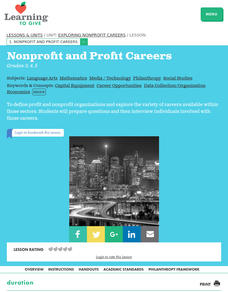Curated OER
Battle of Stones River
Students will read the story "Battle of Stones River" and define a set of vocabulary words. In this Civil War lesson plan, students complete a fill-in-the-blank vocabulary activity after reading the story and defining the words.
Curated OER
Match the Environment Group with the Correct Sector
Students identify different types of environmental organizations. They connect each organization to one of three economic sectors. They examine how each organization is different in their goals and purposes.
Curated OER
Jamestown Journey Part 2
Fourth graders create a chart or web to display qualities and characteristics of a good leader.
They write a paragraph describing the qualities of a good Jamestown leader. Finally, 4th graders contribute to small group discussion about...
Curated OER
Nonprofit Environmental Groups
Students examine the importance of nonprofit organizations when it comes to the environment. They discover how to evaluate different organizations. They research different organizations and present their findings to the class.
Curated OER
Nonprofit and Profit Careers
Learners examine the difference between profit and nonprofit organizations. They identify careers that are available in each sector as well. They develop their own questions and interview people who are in those careers.
Curated OER
Barnacles: Harder than Cement
Fourth graders watch the movements of the complex animal hidden inside the tiny barnacle shells. This lesson allows students to study the behavior, adaptation, and larval stage of the barnacle.
Curated OER
A Newspaper?
Sixth graders reinforce understanding of fractions through use of newspapers.
Curated OER
Permutations
In this permutations worksheet, 6th graders solve and complete 5 different types of problems. First, they write a simple conceptual art plan with no more than 3 instructions. Then, students use graph paper and a pencil to draw a plan....









